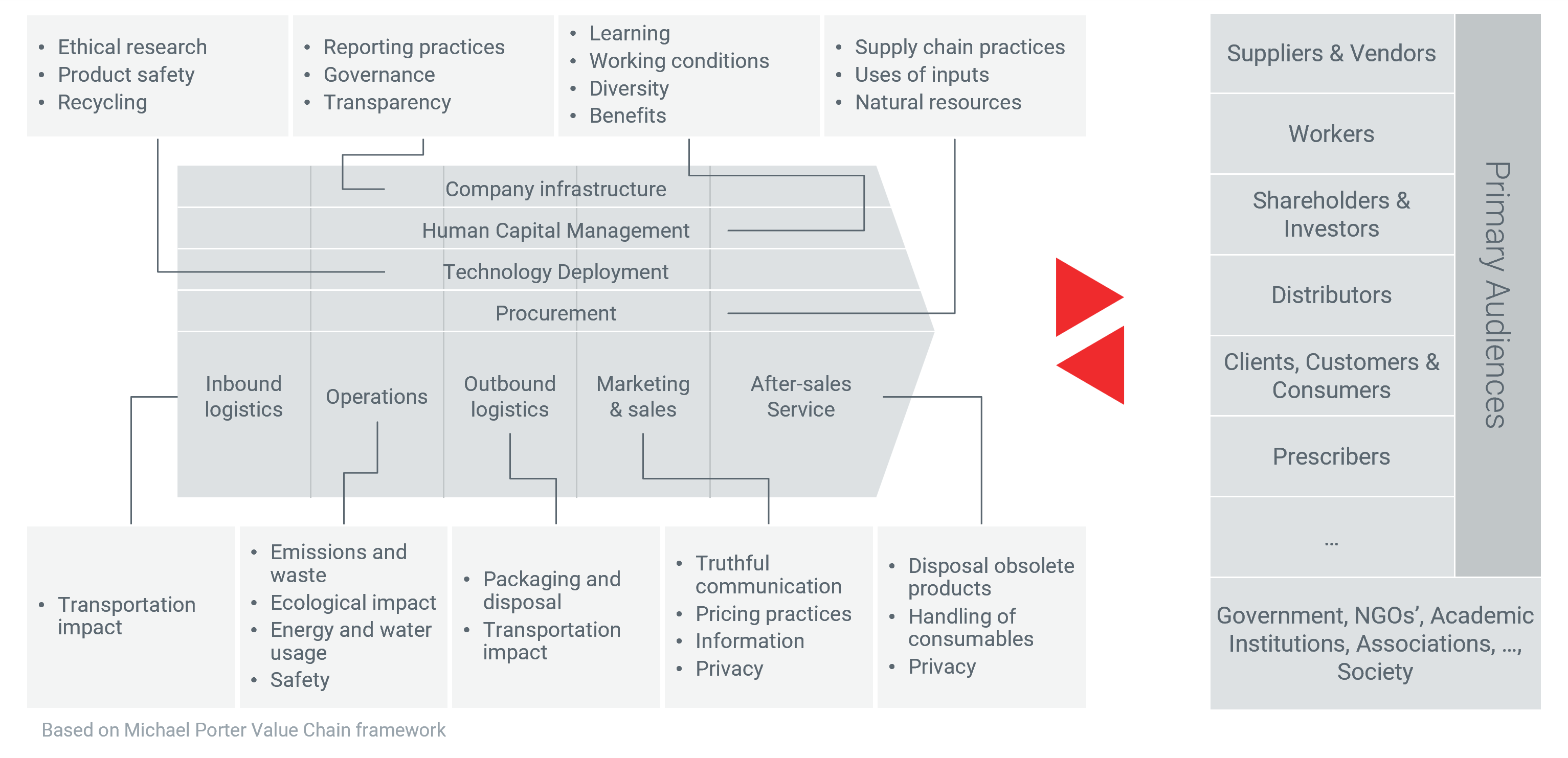Fast Fashion and Sustainable Lifestyle
Research developed by Maelys Tarouilly, Margaux Veyne, Pietro Abenante, and Terry Gestin from the ESCP Business School’s Bachelor Programme
Fast fashion refers to the rapid production and distribution of trendy clothing at affordable prices. It allows consumers to stay up-to-date with the latest styles and frequently update their wardrobes.
Its key characteristics are:
- Quick Turnaround: Brands like Zara and H&M introduce new collections frequently, sometimes weekly.
- Affordability: Low prices attract shoppers, encouraging them to buy more.
However, as we all sensed, unfortunately, fast fashion has significant environmental consequences.
According to the UN, the consequences of this industry for the planet and the people:
- It’s responsible for 10% of global carbon emissions, 20% of global wastewater, and 24% of insecticides.
- It also contributes to the depletion of natural resources, such as water, cotton, and oil.
- It generates a lot of waste, as millions of tons of clothing end up in landfills or incinerators every year.
In addition, the social impact of fast fashion is alarming. It relies on the exploitation of workers in developing countries, who often face low wages, long hours, unsafe conditions, and human rights violations.
In certain cases, it also affects the health and well-being of consumers, who may experience stress, anxiety, and dissatisfaction from the pressure to keep up with the trends and buy more than they need.
Value Chain
All of the above means that the sustainable fast fashion is an intriguing paradox. Let’s delve into its complexities and the significance of its value chain:

Resource Demands:
- Water Usage: Clothing production consumes substantial water resources.
- Chemical Usage: The process involves chemicals harmful to the environment.
- Greenhouse Gas Emissions: Emission levels are high due to production.
Labor Issues:
- Underpaid Workers: Reports reveal underpayment and unsafe conditions for factory workers.
- Material Handling Risks: Cotton and leather processing poses health hazards.
- Waste Management: Disposal: Consumers discard unfashionable or worn-out garments, leading to excessive waste.
Importance of Addressing These Challenges:
- Environmental responsibility: Brands must reduce their environmental footprint
- Ethical labour practices: Ensure fair wages and safe working conditions
- Circular economy: Encourage recycling, upcycling and reuse of materials
- Transparency: Technologies such as AI and blockchain enable traceability throughout the value chain, from sourcing raw materials to shipping and reuse
Sustainable fast fashion requires a holistic approach that balances style, affordability, and environmental and social responsibility. By transforming the value chain, fashion companies can contribute to a more sustainable industry.
Analysed Brands
C&A
In general C&A is a company that hasn’t reached perfect environmental and ethical Standards. However, they are acknowledging that change is needed and immediately.
In this case, they have upcoming goals and challenges to become an optimal choice for environmentally conscious customers.
H&M
Overall, we can say H&M is a company that understands the great challenges of the Industry it operates in.
It has taken concrete measures to curtail its environmental impact and it has made the good treatment of its employees a priority.
However, it needs to speed up its research on new materials that could further reduce H&M’s impact on the planet.
Asos
So how sustainable and responsible is Asos? Overall, Asos gets a “Not Excellent Enough” rating.
Implementing policies to reduce carbon emissions by banning fur and other animal-based products, and providing a more conscientious selection, some progress has been made. But there is still a lot that can be done. For Asos to receive a higher grade, it must make progress in every category.
Zara
Zara has achieved significant success in the fashion industry, becoming one of the world’s largest fashion retailers. Some of the key results that have contributed to it success include:
- Strong financial performance: Zara’s parent company, Inditex, reported revenues of €28.3billion in2020, with Zara accounting for a significant portion of this.
- Large global presence: Zara operates over 2,000 stores in 96 countries, making it one of the most widely recognized fashion brands in the world.
- Fast fashion approach: Zara’s ability to quickly respond to changing fashion trends and bring new designs to the market in a matter of weeks has been a key driver of its success.
- Efficient value chain: Zara’s vertically integrated system, which includes in-house design, production, and logistics capabilities, allows it to maintain high levels of efficiency and quality throughout its operations.
- Strong brand image: Zara has created a strong brand image through its unique in-store experience, focus on customer service, and marketing efforts, which has helped to drive customer loyalty and brand recognition.
Final Thoughts
We need to rethink our relationship with fashion and adopt more conscious and responsible practices. That’s key for developing a real sustainable lifestyle
We can do this by buying less, choosing quality over quantity, supporting ethical brands, donating or recycling our old clothes, and educating ourselves and others about its impact.
For more information, please do not hesitate to contact us.
Sources:
- ASOS | Online Shopping for the Latest Clothes & Fashion
- ASOS | Company Overview & News (forbes.com)
- Brands (inditex.com)
- C&A corporate website (c-and-a.com)
- C&A – Sustainability Facts, Rating, Goals | Panaprium
- Can‘FastFashion’BeSustainable?(forbes.com)
- Climate – H&M Group (hmgroup-prd-app.azurewebsites.net)
- Collect, recirculate and recycle – H&M Group (hmgroup-prd-app.azurewebsites.net)
- Company management – H&M Group (hmgroup-prd-app.azurewebsites.net)
- Cotton – H&M Group (hmgroup-prd-app.azurewebsites.net)
- H&M is one of fashion’s biggest polluters. fastcompany.com
- H&M Marketing Strategy – Second Global Clothing Retailer (startuptalky.com)
- H&M Mission Statement 2024 (mission-statement.com)
- H&M Employees, Statistics, Diversity, Demographics – Zippia
- H&M: number of transactions by channel worldwide 2019 | Statista
- H&M: supplier and factory numbers 2023 by country | Statista
- How can fashion industry supply chain become sustainable?
- Innovation – H&M Group (hmgroup-prd-app.azurewebsites.net)
- Markets and expansion – H&M Group (hmgroup-prd-app.azurewebsites.net)
- Materials – H&M Group (hmgroup-prd-app.azurewebsites.net)
- MDS | The global fashion business journal (themds.com)
- Number of H&M employees worldwide 2022 | Statista
- Our Leadership Team | C&A corporate website (c-and-a.com)
- Our values – H&M Group (hmgroup-prd-app.azurewebsites.net)
- Packaging – H&M Group (hmgroup-prd-app.azurewebsites.net)
- Purpose & Values | C&A corporate website (c-and-a.com)
- Responsible Marketing – H&M Group (hmgroup-prd-app.azurewebsites.net)
- Stylethat’ssustainable:Anewfast-fashionformula|McKinsey
- Supporting a greener transport – H&M Group (hmgroup.com)
- Sustainability Strategy – Worker wellbeing | C&A corporate website
- SustainablePracticesinFastFashion|SpringerLink
- The MARKETING and ADVERTISING STRATEGY of ZARA
- Working conditions – H&M Group (hmgroup-prd-app.azurewebsites.net)
- Zara – Value Chain by Alexander Goerss on Prezi Next
- ZARA LOGISTICS | The blog of Logistics at MGEPS at UPV (wordpress.com)
Image:
- CottonBro, Pexels









I think fast fashions impact on sustainability is overstated. What do you guys think?
Isnt it crazy how fast fashion can be both convenient and harmful at the same time?
Its a vicious cycle, isnt it? The convenience of fast fashion blinds us to the harm it causes. We need to break free from this toxic relationship and prioritize sustainability over trends. Our planet and future generations depend on it.
Should we boycott fast fashion or push for more sustainable practices?
I disagree with the articles view on fast fashions impact on sustainability.
I see your point, but fast fashion undeniably contributes to environmental degradation and unethical labor practices. Ignoring these impacts wont make them disappear. We need to hold the industry accountable for a more sustainable future.
Is fast fashion really worth the convenience? Lets rethink our choices. #sustainability
Fast fashion may be convenient, but the true cost is too high. Lets prioritize our planet over fleeting trends. Sustainable choices lead to a brighter future for all. #ethicalfashion #consciousconsumer
Is fast fashion really worth the convenience? Lets rethink our priorities. 🤔🌍 #SustainableFashion